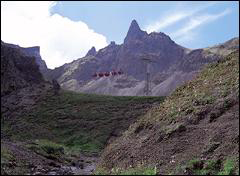CAC CONTENTS
-

-
CAC Contents
-
Vigorous climbing movement in Korea
- Outline
- Mountaineering around the capital
- Mt. Sorak with fascinating sights
- A great volcaic upheaval
- Scaling of high mountains aborad
- Overseas expeditions by CAC & KAF
- Vigorous climbing movement in Korea
- New Start
- Korean Rock by Rick Ruffin
- Seoul Big Slab by Rick Ruffin
- Winter Trill in Korea by Cho sung dae
Vigorous climbing movement in Korea
Vigorous climbing movement in Korea
Nearly all organizations, high schools and universities across the country have mountaineering or hiking clubs, whose members visit in groups suburban and renowned mountains in provinces on holidays. Hikers and climbers of both sexes, young and old, estimated to number between three million and four million by newspapers,
enjoy mountaineering with vigor.
People engaged in the nationwide sport are increasing by geometric progression.
This can be attributed partially to improved living standards the Korean enjoy thanks to the remarkable economic growth they have brought about since the 1960s.
It is also part of the world trend of leisure enjoyment stemming from a human instinct of associating themselves with nature and mountains. Also responsible for the phenomenon is the facts that Korea is geomorphologically characterized by abundant hills and mountains, and that the Koreans have had to climb mountains from time immemorial.
-

-
Legend have it that Tangun, who founded Korea 4317 years ago or in 2333 B.D., descended on Mt. Paekdu, the highest one on this peninsula. Brave and courageous youths called Hwarang who provided the main source of strength to Silla Dynasty that unified Korea in 676 A.D. were trained mainly in mountains. The Koreans thus have a historical tradition of appreciating mountains and youths in particular are very keen on mountain climbing.
Perhaps because of such traditions the highest and scenic mountains in the country have long been designated as devine or sacred mountains, to which commoners paid religious pilgrimage.
All this may explain why mountaineering activities are carried out in Korea nowadays so vigorously.
Many individual hikers and climbers and climbers' clubs belong to CAC, KAF, University and High School Alpine Federation, Working Places Alpine Federation and Tourist Alpine Society, the latter three of which came into being about ten years ago. These organizations with the support and help provided by various social bodies have conducted mountaineering movement across the country.
The vigorous climbing activities in South Korea described above reflect the vigor and vitality with which the nation has achieve economic and social growth in recent decades.
Lastly I wish to extend a hearty congratulation to the Korean mountaineering circles on the occasion that they host the 46th UIAA General Assembly in Seoul this year, probably the highest tribute of recognition to them.
The author Kim Jeong-tai was a well-known alpinist and skier in korea. He was a member of the Baekryong Club, the first Korean alpine body, and joined to organize Corean Alpine Club to which he had been serving as a vice-president for two decades.


 ENGLISH
ENGLISH


